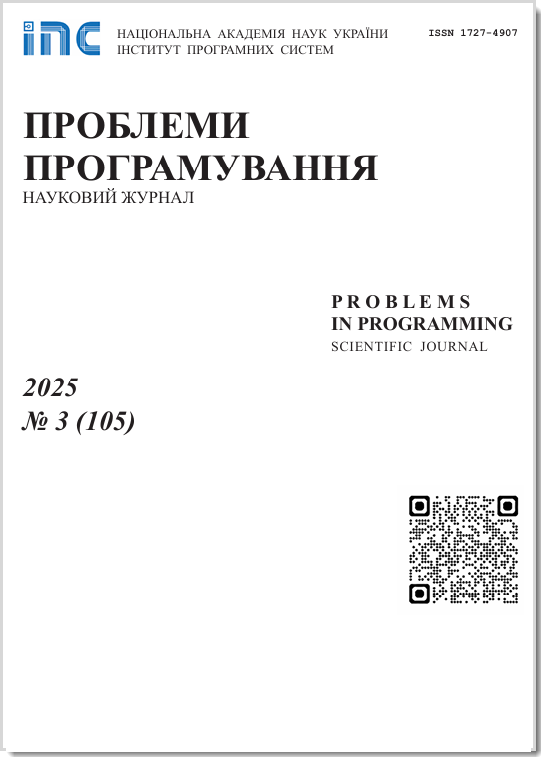Software framework for satellite spatial resolution enhancement
Abstract
Remote sensing provides many crucial data today. Thankfully to the ease of access, global coverage and short revisit time intervals it became possible to retrieve global Earth’s land coverage data effortlessly. This data can provide useful information of the Earth’s land cover current state to make necessary assessments, forecasts, and other tasks that can be in handy for humanity, governments or even farmers. One of the main characteristics of image data quality is its spatial resolution. Thus, spatial resolution enhancement is a relevant topic nowadays. In this article a generalized software framework for satellite spatial resolution enhancement is presented. Due to sensitivity to the satellite data distortion, the applied method considers fusion of several low-resolution images into a single super-resolved one. The proposed framework takes into account satellite data specificity, that is given in a corresponding section. The framework was described to be capable to operate with radar and optical data. For the radar data a corresponding module, that ensures applicability of the super-resolution approach, is given. The framework was implemented using, mainly, C/C++ programming language and tested on a series of real satellite images. The result was evaluated using the modulation transfer function (MTF) approach and has shown an increasement in 135.91% for threefold scale optical images spatial resolution enhancement and 30.93% for the twofold scale radar spatial resolution enhancement. Despite the given representability of the test image set, the presented approach can be beneficial for the tasks that may have a need of the satellite data with higher spatial resolution. The paper concludes with overview of the authors implementation of the given framework and highlighting its drawbacks with suggestions for improvement.
Prombles in programming 2024; 2-3: 163-172
Keywords
Full Text:
PDFReferences
Curry, E., Metzger, A., Zillner, S., Pazzaglia, J.-C. and García RoblesA.(2021). The elements of big data value : foundations of the research and innovation ecosystem. Cham: Springer.CrossRef
Goodfellow, I., Bengio, Y. and Courville, A. (2016). Deep Learning. Cambridge, Massachusetts: The Mit Press.
Lock, M., Saintilan, N., Iris van Duren and Skidmore, A.K. (2023). Monitoring Coastal Water Body Health with Sentinel-2 MSI Imagery. Remote Sensing, 15(7), pp.1734-1734. CrossRef
Nguyen, M., Baez-Villanueva, O., Bui, D., Nguyen, P. and Ribbe, L. (2020). Harmonization of Landsat and Sentinel 2 for Crop Monitoring in Drought Prone Areas: Case Studies of Ninh Thuan (Vietnam) and Bekaa (Lebanon). Remote Sensing, 12(2), p. 281. CrossRef
Szabó, A., Odunayo David Adeniyi, János Tamás and Nagy, A. (2021). Assessment of a Yield Prediction Method Based on Time Series Landsat 8 Data. Acta horticulturae et regiotecturae, 24(s1), pp.12-15. CrossRef
Hu, X., Ban, Y. and Nascetti, A. (2021). Sentinel-2 MSI data for active fire detection in major fire-prone biomes: A multi-criteria approach. International Journal of Applied Earth Observation and Geoinformation, 101, p. 102347. CrossRef
Mykola Lubskyi, Tetiana Orlenko, Iryna Piestova, Artem Andreiev and Lysenko, A. (2023). Evaluation of indicators for desertification risk assessment of Oleshky sands desertification based on Landsat data time series. Ukraïnsʹkij žurnal distancìjnogo zonduvannâ Zemlì, 10(1), pp.17-28. CrossRef
Brown, C.W., Connor, L.N., Lillibridge, J.L., Nalli, N.R. and Legeckis, R.V. (2007). An Introduction to Satellite Sensors, Observations and Techniques. Remote sensing and digital image processing, pp.21-50. CrossRef
Fathi, Hadhoud, M.M. and El-Khamy, S.E. (2012). Image Super Resolution and Applications. CRC Press.
Assia Kourgli and Youcef Oukil (2013). Very High Resolution Satellite Images Filtering. CrossRef
Lu, T., Wang, J., Zhang, Y., Wang, Z. and Jiang, J. (2019). Satellite Image Super-Resolution via Multi-Scale Residual Deep Neural Network. Remote Sensing, 11(13), 1588 p. CrossRef
Zhou, J., Luo, X., Rong, W. and Xu, H. (2022). Cloud Removal for Optical Remote Sensing Imagery Using Distortion Coding Network Combined with Compound Loss Functions. Remote sensing, 14(14), pp.3452-3452. CrossRef
Oh, Y.D., Kamal Sarabandi and Ulaby, F.T. (1992). An empirical model and an inversion technique for radar scattering from bare soil surfaces. IEEE Transactions on Geoscience and Remote Sensing, 30(2), pp.370-381. CrossRef
S. Susan Young, Driggers, R.G. and Eddie Lynn Jacobs (2008). Signal Processing and Performance Analysis for Imaging Systems. Artech House.
Stankevich, S., Popov, M., Shklyar, S., Sukhanov, K., Andreiev, A., Lysenko, A., Kun, X., Shixiang, C., Yupan, S., Xing, Z. and Boya, S (2020). Subpixel-shifted satellite images superresolution: software implementation. WSEAS TRANSACTIONS on COMPUTERS, 19, pp.31-37. CrossRef
Stankevich, S.А., Popov, M., Shklyar, S., Lysenko, A., Artem Andreiev, Xing, K., Cao, S. and Tao, R. (2023). Satellite Imagery Superresolution Based on Optimal Frame Accumulation. Springer proceedings in physics, pp.395-412. CrossRef
DOI: https://doi.org/10.15407/pp2024.02-03.163
Refbacks
- There are currently no refbacks.









